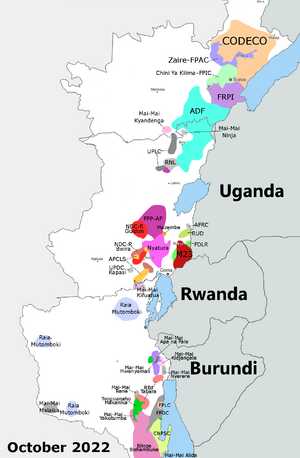Kivu conflict facts for kids
Quick facts for kids Kivu conflict |
|||||||||
|---|---|---|---|---|---|---|---|---|---|
| Part of the aftermath of the Second Congo War | |||||||||
|
Approximate map of current military situation in Kivu. |
|||||||||
|
|||||||||
| Belligerents (see full list) | |||||||||
|
Rwandan-aligned militias: Ugandan-aligned militias:
Foreign state actors: |
Pro-government:
Supported by: |
Anti-Ugandan forces:
Anti-Rwandan militias:
Anti-Burundi militias:
|
Mai-Mai militias: |
||||||
| Commanders and leaders | |||||||||
|
|
||||||||
| Strength | |||||||||
| 6,000–8,000 CNDP (2007) 5,500+ M23 (2012) |
2004: 20,000 total troops; 2008:
2013: 22,016 UN Monusco Uniformed personnel (2013) |
2,000 FDLR 3,000 FNL/Palipehutu Hundreds of FNL–Nzabampema |
Several thousand Raia Mutomboki militia 10,000+ other armed groups 1,500 ACPLS |
||||||
| Casualties and losses | |||||||||
| CNDP: 233 killed | FARDC: 71 killed BDF: Unknown |
Unknown | Unknown | ||||||
| More than 1.4 million internally displaced persons, hundreds of thousands of excess deaths, 11,873+ people killed (including civilians and combatants of each sides) |
|||||||||
The Kivu conflict is an umbrella term for a series of protracted armed conflicts in the North Kivu and South Kivu provinces in the eastern Democratic Republic of the Congo which have occurred since the end of the Second Congo War. Including neighboring Ituri province, there are more than 120 different armed groups active in the eastern Democratic Republic of Congo. Currently, some of the most active rebel groups include the Allied Democratic Forces, the Cooperative for the Development of the Congo, the March 23 Movement, and many local Mai Mai militias. In addition to rebel groups and the governmental FARDC troops, a number of national and international organizations have intervened militarily in the conflict, including the United Nations force known as MONUSCO, and an East African Community regional force.
Conflict began in 2004 in the eastern Congo as an armed conflict between the military of the Democratic Republic of the Congo (FARDC) and the Hutu Power group Democratic Forces for the Liberation of Rwanda (FDLR) in the Democratic Republic of the Congo. It has broadly consisted of three phases, the third of which is an ongoing conflict. Prior to March 2009, the main combatant group against the FARDC was the National Congress for the Defence of the People (CNDP). Following the cessation of hostilities between these two forces, rebel Tutsi forces, formerly under the command of Laurent Nkunda, became the dominant opposition to the government forces.
The United Nations Mission in the Democratic Republic of Congo (MONUSCO) has played a large role in the conflict. With 21,000 soldiers in the force, the Kivu conflict constitutes the largest peacekeeping mission currently in operation. In total, 93 peacekeepers have died in the region, with 15 dying in a large-scale attack by the Allied Democratic Forces, in North Kivu in December 2017. The peacekeeping force seeks to prevent escalation of force in the conflict.
CNDP was sympathetic to the Banyamulenge in Eastern Congo, an ethnic Tutsi group, and to the Tutsi-dominated government of neighboring Rwanda. It was opposed by the FDLR, by the FARDC, and by United Nations forces.
In July 2024, a United Nations report pointed to Uganda's links with the M23 and accused the Democratic Republic of Congo of having started arming other groups opposed to M23 in July 2023. M23 and other groups are engaged in a wide range of abuses in the region: recruitment of child soldiers, violence against the civilian population, looting, illegal mining, and corruption.
Images for kids
See also
 In Spanish: Guerra de Kivu para niños
In Spanish: Guerra de Kivu para niños
- Ituri conflict
- List of conflicts in Africa





